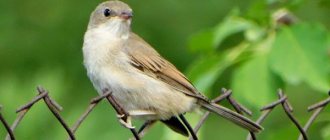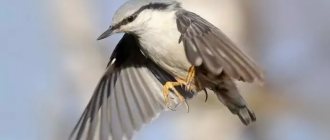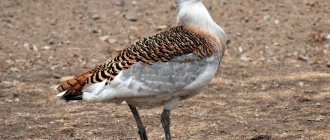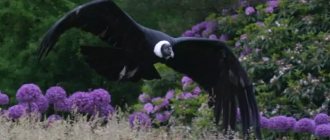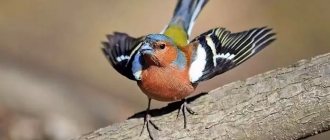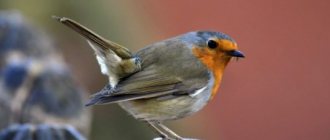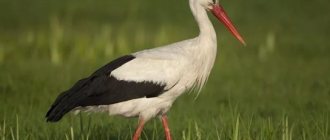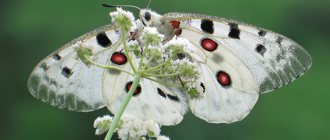What does it look like
— Advertising —
Photo of a stork in the meadow
The stork is a stately, tall bird with a large barrel-shaped body, thin stilted legs and a long, straight, conical beak. The neck is long, flexible, and sharply curved back at the top. The head looks forward, the end of the beak is directed downward.
In the plumage of all types of storks there are two colors - white and black, each variety has a different color ratio. The powerful paws are partially feathered, the skin on them is red-gray, covered with sparse gray down. Toes without webs.
Two storks in the water opened their wings
— Advertising —
Storks have huge wings, their span is 1.5-2 meters. When fully expanded, the back of the wings forms a straight line. The wings move with a large amplitude, which allows the bird to quickly gain height. In flight, storks can reach speeds of up to 45 km/h. In flight with rising air currents they glide. Soaring is achieved due to wide wings beveled at the end, an elongated forearm and a short shoulder. While soaring, the stork goes into rest mode: cardiac activity decreases, the pulse is 100-120 beats per minute. A short sleep lasts 15-20 minutes, then the bird enters the wakefulness stage and increases its speed of movement.
The tail of storks is of moderate length, blunt at the end. It's always black.
Photo of a stork close up
Storks' faces are not feathered. The skin around the eyes may be black, red or blue, depending on the species. The color of the stork's beak is red, but there are birds with gray and black beaks.
Stork beak
Stork in nature
As has been noted, the beak of storks is long and thin, straight, tapered at the end. The bird “works” with it like tweezers, capturing aquatic life from a shallow depth. The stork holds the victim across its body, then makes a sharp swing of its head, tossing the carcass, and swallows it completely.
Photo of a stork's beak
Those who have ever watched a stork may have noticed that storks knock with their beaks. This is how birds communicate with each other. Due to the peculiar structure of the vocal apparatus, most species of storks are deprived of the ability to make sounds similar to other birds. The exception is the Black Stork. It may make sounds similar to loud inhalation. The stork knocks with its beak, and the air passing between the halves of the beak transforms into a quiet whistle or hiss. By clinking their beaks, birds warn their relatives about danger, show sympathy, and mate. Other storks click their beaks without any whistles. Males constantly click their beaks during love games. Their “songs” are a series of rapid chattering sounds of their jaws. During the mating ritual, the male and female knock their beaks together as a sign of sympathy.
Why do storks stand on one leg?
The stork stands on one leg.
The unusual habit of the stork to stand on one leg is not a bird’s whim, but a vital necessity. Birds spend most of their time in the water, and if they stand on both legs, they will quickly freeze. Therefore, storks have to bend one leg and hide it in the feathers under their belly - this is how birds carry out thermoregulation. Storks, like flamingos and herons, sleep standing on one leg. The peculiar structure of the bird's paws helps maintain balance while standing on one leg. At the same time, the muscles in this position are relaxed and the birds do not get tired.
Natural enemies
Due to the large size and high location of the nests, storks do not have many enemies. Most often, their numbers are declining due to climate change, landscape changes and human activity. A dangerous enemy in modern cities is power lines. In addition, it has been precisely proven that sometimes storks themselves clear their population of weak individuals.
Photo: proprikol.ru
Starling (50 photos): description of the bird, habitat and what it eats
Female and male: differences
Male
The male weighs up to 4 kilograms. The male representative has a powerful body with a retracted chest, wide long wings, and a medium-sized tail. In some species, the area around the eyes turns blue during the breeding season.
Female and male stork in the nest
Female
The weight of the female varies from 2 to 2.5 kilograms. Her body is not as built up as that of the male. The neck is shortened, shaped like the number “2”. The beak is pressed to the neck.
Marabou
The Latin name is Leptoptilos. This is the common name of the genus and includes Javanese, African, and Indian marabou. Like the Brazilian jabiru, these storks are large, with a large head and a massive beak. Even adult birds look more like ugly ducklings than beautiful swans. The wings reach 70 centimeters in length, and the birds weigh about 5 kg. The marabou has an unofficial name - “adjutant”, received for its gait, like that of the military. There is no feathering on the bird's head, as well as on the peculiar protrusion of the neck, which helps to hold the heavy beak. The tail, back and wings are dark gray or black.
Spreading
Habitat of the stork
In Russia, storks live in the territory from the Baltic Sea to the Urals, then in Southern Siberia and the Far East, bypassing the Kuril Islands and Kamchatka. A small group of black storks lives in Chechnya and Dagestan. Outside Russia, they live in Asia, Eastern Europe, Africa, and are found sporadically in the Netherlands, Iceland and southern Saxony. In North America and England, as well as in Australia, there are no storks of the genus Ciconia.
Where do storks live
A stork drinks water from a lake.
Storks live in quiet, dense deciduous forests, next to swamps and lakes rich in aquatic life. Storks live in tall trees. These birds are found in hilly and mountainous areas. Some species of storks, in particular White storks, nest next to humans. They build nests on power lines and roofs of outbuildings.
Habitat
On European territory there are black and white storks, which are classified as migratory birds. In central Europe, these birds appear in February/March. These birds are not found in the vast expanses of England.
White-bellied storks live within the African continent, from Ethiopia to South Africa. As for white-necked storks, they can actually be found in southern Thailand; Malayan storks are found in western Malaysia and Brunei. These birds prefer to nest in biotones that are untouched by humans and represent lowlands with the presence of forest plantations. In addition, storks settle in floodplains of rivers, as well as near various fresh water bodies.
Interesting moment! Some populations of these birds are found in northern Korea, northeastern China, and also in Mongolia. These birds winter in the south, as well as in southeast China. These areas are characterized by the presence of wet areas, small ponds, and rice fields.
The habitat of American storks extends to the South American continent, starting from the expanses of Venezuela and ending with the territories of Argentina. Here they nest in damp areas, as well as near agricultural lands. Far Eastern storks prefer to live in the Far East, or rather in Primorye and the Amur region, as well as in the basins of rivers such as the Amur, Zeya and Ussuri.
Stork's nest - be careful
Is the stork a migratory bird or not?
Stork bird in flight
Storks are migratory birds. Every year at the end of summer they fly to warmer climes. The young ones fly away first. Young birds gather in flocks and fly along the same routes and to the same places as their parents. Adults are removed from the site a little later. The birds fly in a wedge at an altitude of 1-2 kilometers. The flight continues throughout daylight hours; at night, the storks make a stop. The distance that birds cover during migration is 6-9 thousand kilometers. In spring, the birds form flocks again and fly back. Young animals can remain “overwintering” from one to three years before reaching sexual maturity.
Species living in South Africa, Central and Southern Europe, America, Japan and Asia lead a sedentary lifestyle, since food remains freely available for them all year round.
When do storks fly away for the winter?
The stork flies away to warmer regions
Like all migratory birds, storks fly away to warmer regions by the beginning of autumn and return back after 6-7 months. Storks from Belarus fly away for the winter in mid-August. The signal for the start of migration is the first night cold snap and shortening of daylight hours. Storks from the Kaliningrad region fly south in early September. In warm autumn, birds stay in their habitat until the end of the month. Storks return from wintering in early March. From the Leningrad region, storks fly south already in July. Returns occur in early April. Chinese storks move away closer to October.
Where do storks spend the winter?
Two storks in a field
Different species of storks have their own wintering place. One of the countries where storks fly is Africa. Storks from Russia migrate to East Africa for the winter, Belarusian storks spend the winter in the south of the African continent. Some species fly to Asia Minor during the summer. Belarusian storks fly southwest to Spain and Gibraltar. Some flocks remain to bask there. Others continue their journey through Morocco, Mauritania, Senegal, and Guinea to the south of the continent. Spanish and Algerian birds join the European storks as the school moves. A significant portion of birds remain for the winter in West Africa, in particular Senegal and Nigeria. Russian birds fly to Africa through Asia Minor and Israel to the east coast of Africa - to Ethiopia, Kenya, and Somalia. In warm winters, the migration route is shortened. If weather conditions permit, storks remain for the winter on the coasts of the Mediterranean and Black Seas.
Where do herons winter?
Herons breeding in the Dnieper delta and Crimea have been found in winter in Italy and Greece, as well as in the west of the African continent. Central Asian populations fly to India and China for the winter, Eastern Siberian populations fly to India, Japan, and Southern China.
Interesting materials:
Where can I get a labor veteran's certificate? Where can I change my pension certificate? Where can I view company financial statements? Where can I view paid taxes? Where can you put up a tent in Crimea? Where can I withdraw money from a Mir card without commission? Where can you see killer whales in Russia? Where can I find out Kbk? Where can I find out Snils number? Where can you find out about your ancestors?
The stork is a symbol of Belarus
A stork stands on one leg on a stump.
In the Republic of Belarus, storks are called “busly” (“buslik” and “lyalko”). Busel is a symbol of Belarus. These birds are clean and peaceful, they are caring parents. Along with swallows, doves and cranes, buslas are sacred birds for Belarusians. With its white wings, the busel shelters the people from everything bad.
Stork eats grass
Busel in Belarus appears as a wise, ambitious being with high moral qualities. According to ancient legend, the busel was once a man, but God turned him into a bird. The arrival of a bird from wintering means the arrival of spring, the rebirth of life. The image of the busla in Belarus can be found in art and folk art.
There are many white storks in Belarus. 15 years ago there were 20 thousand pairs in the republic. Today the number of birds has increased by another 10 thousand. Population growth is associated with an increase in suitable nesting sites. The Belarusian climate is mild, there is enough habitat for birds.
Two storks in flight
Storks live near human settlements, since food can always be found nearby. These birds settle only where there is plenty of food for them. In the wild, storks settled on tree branches near swamps. But due to the reduction of places suitable for living and food, storks began to move closer to people. Today, storks feed in hay pastures and arable lands, in vegetable gardens and orchards.
Lifespan
How long do storks live? In ideal artificial conditions, birds can live for more than a quarter of a century. How long do storks live in natural conditions? A rare individual lives up to 15 years. Factors that hinder the long life of storks include environmental conditions, natural selection, diseases, lack of food, and harm caused by humans and predators. Sometimes representatives of this family themselves shorten the lifespan of their fellows by pecking at sick birds. It has been noticed that storks live longest where the energy is positive, where there are no people swearing nearby, where peace and tranquility reign.
Nutrition
Stork on the hunt
Storks are birds of prey. They hunt reptiles and fish, snakes and small mammals. Their diet includes frogs, eels, salamanders, and crabs. During the breeding season, small fish, small birds and animals are added to the menu. Storks feed their chicks with snails, worms, mollusks, beetles and their larvae. Storks feed on snakes, and do not shy away from poisonous species, such as vipers. Creeping up on the victim unnoticed, the stork grabs the snake with its tenacious beak and begins to forcefully hit the ground. Having stunned it, the stork swallows its prey whole.
What do white storks eat?
Photo: White stork in Russia
The diet of storks is extremely varied. The stork's diet includes:
- worm;
- locusts, grasshoppers;
- various arthropods;
- crayfish and fish;
- insects;
- frogs and snakes.
Interesting fact: Storks can eat poisonous and dangerous snakes without harm to their health.
Sometimes storks can also feed on small animals such as mice and small rabbits. Storks are birds of prey; the size of their prey depends only on the ability to swallow it. Storks do not break apart and cannot chew their prey. They swallow it whole. Near a body of water, storks like to rinse their prey in water before eating, this makes it much easier to swallow. In a similar way, storks wash frogs dried in mud and sand. Storks regurgitate undigested parts of food in the form of grebes. Such grebes are formed over several days, and they consist of wool, insect remains and fish scales.
Storks hunt near their nests in meadows, pastures, and swamps. Storks are large birds and for normal life, a bird kept in captivity requires up to 300 grams of food in the summer, and 500 grams of food in the winter. In the wild, birds consume more food, since hunting and long flights are quite energy intensive. Storks eat almost all the time. On average, a pair of storks with two chicks consumes about 5,000 kJ of energy obtained from food per day. Particularly profitable and convenient food for storks are small rodents and other vertebrates.
Depending on the time of year and habitat, the bird’s diet may vary. In some places, birds eat more locusts and winged insects; in other places, the diet may consist of mice and amphibians. During climate change, storks do not experience a shortage of food and quickly find food in a new place.
Lifestyle and behavior
Stork in the swamp
Predators spend most of the day searching for food. They look for food by standing in the water with their wings spread and their head bowed low. As soon as prey appears in the water surface, the stork throws its head forward and grabs the victim with its long beak. Hunting, as a rule, takes place alone. If food resources allow, then the birds flock to the table to eat to their heart's content. Storks forage for food in the water, but sometimes come to land to hunt ferrets, mice, and gophers.
Photo of a flock of storks on a field
During the breeding season, storks stay in pairs; birds gather in flocks only during migration. Surprisingly, before flying to hot countries, storks perform a “cleansing” - sick and old birds are beaten to death with their beaks. This is done so that during a long flight, weakened birds do not delay the flock. In addition, sick birds are carriers of infections, which can lead to the spread of diseases among healthy birds.
Storks return from their winter quarters in March-April. The males arrive first. The first thing they do is start arranging their home.
Argala
The more famous of the two representatives of this genus, the argal (L. dubius), ranging from Northern Hindustan through Eastern India to Sumatra, Java and Borneo and often found in the vicinity of large cities, appears, for example, in large flocks in Calcutta in the hot season. Previously, when the cleanliness of the city still left much to be desired, the argala at night usually sat on the roof of the governor’s house and other tall buildings in the city.
Argala stork
As a useful cleaner of street sewage, he enjoys the protection of the law in many areas, but, in addition to carrion and other garbage, he also eats reptiles, frogs and fish. This bird is also called the bald stork orderly . This bird hatches its eggs in large societies, often together with pelicans, and it is remarkable that although it has no vocal muscles and usually cracks its beak like our storks, it can nevertheless produce a cry reminiscent of the lowing of a cow.
stork nest
Storks in the nest
Storks build huge nests, measuring 1.5 * 1 m. The weight of a stork's nest is 200-250 kilograms. Storks make nests on poles, roofs of buildings, and treetops near water bodies. The presence of water near the “house” is an important condition when searching for a nesting site, since the birds are very voracious and the presence of food nearby is their priority. Having once built a nest, birds use it throughout their entire lives. Every year the storks return to their nest. It is easier for them to renovate an old home than to waste energy each time building a new one.
Photo of a family of storks in a nest
The male builds the nest. Construction takes him two weeks. The bird carries twigs and large branches to the place and weaves them together. The bottom is lined with grass or hay. Birds living near humans use objects found near the house or in the barnyard as bedding - old rags, wool, paper, straw.
Lonely stork in its nest
Each species of stork has its own peculiarity of nest construction. White storks are sloppy in this matter; their nests are always hastily built, looking like a bowl of branches thrown on top of each other. By the end of the season, holes and gaps form in their nests, so the birds have to patch the walls and bottom every year. Black storks have neat and compact “houses”. Strengthen the walls of the bird with clay or damp soil. The nests serve their owners for many years. Every year the nest of the stork family becomes larger: the walls thicken, the depth increases. Sometimes storks live in the same nest with small passerine birds.
Reproduction
Photo of a family of storks
Having finished building the nest, the male begins to search for a partner. Or rather, the female herself chooses a male from among those who have already acquired a home. The female who flies to the nest first becomes the male's spouse. Sometimes females fight for a specific male, while the male does not take part in the fight. Storks are monogamous birds. The bird lives with one partner for the rest of its life. The only exception is the death of one of the partners, then the lonely bird chooses a new mate. Birds mate in the air, while the birds stay parallel to each other, rushing high into the sky.
Photo of stork eggs in a nest
The stork lays from two to four eggs measuring 6*5 centimeters. The shell is white, matte, rough. Laying lasts a week, eggs appear at intervals of two to three days. Incubation begins with the first egg. Storks hatch their chicks one at a time: while the male sits in the nest, the female feeds at this time. Then the birds change places. 30 days after the first egg is laid, the chicks appear.
Where do swallows fly from Belarus?
Their path lay in Egypt, Sudan, Kenya, Tanzania, all the way to southern Africa. In total, they fly about 9 thousand km in one direction only.
Interesting materials:
What names suit each other Anna? What names suit each other Egor? What names are popular in 2022? What names are popular in Kyrgyzstan? What are the names in August? What are the names in Germany? What names are trending? What are female names? What male names are suitable for the name Sonya? What are the most popular boy names?
Stork chick
A stork chick is having lunch.
Since all eggs have a different period of postembryonic development, stork babies are born in different sizes. The smallest chick is born from the last egg laid. Mature stork chicks (maturely hatching) have fluff on their bodies, the chicks see and hear well, and can move around in the nest. The skin of immature chicks (immature hatchlings) is bare, they are blind and helpless, and cannot independently maintain normal body temperature. The skin of the cubs is light gray, the beak is orange. By 40 days of life, young storks fledge.
Photo of a stork hatching from a nest
Stork chicks look larger than the babies of other bird species similar to storks. Scientifically, a baby stork is called a “chick.” People call the offspring of storks “storks.” If we are talking about one chick, then we can say “stork”.
Why do storks throw their chicks out of the nest?
Stork chick in the nest
Parent storks are attentive and caring towards their babies. For the first two weeks, they warm the chicks, take turns feeding them, and make sure that they are not eaten by other birds of prey. However, these birds are not without hard-heartedness: storks closely monitor the development of the young, and if they notice that the offspring have weak and frail specimens, then they coldly throw the chicks out of the nest. Such cruelty is explained by the fact that immature chicks are not viable, and therefore parents prefer not to waste energy, time and food on them. Birds either peck at weak and sick chicks or throw them out of the nest. There is a reason for this behavior: immature chicks are disposed of so that stronger and more mature chicks can get more food. When parents have nothing to feed their newborns, the last hatched chick usually lags behind in development. It may be trampled by other chicks or thrown out of the nest. or he himself may fall out of the nest due to lack of space. We are talking about natural selection - whoever is stronger survives.
Photo of stork chicks falling out of the nest
Adult storks do not always throw out only weak chicks from the nest. In hungry years, parents can also get rid of healthy offspring, leaving 1-2 chicks in the nest, which they can feed. Sometimes strong chicks themselves get rid of competitors - they throw their brothers and sisters out of the nest. Due to lack of food, adult storks eat their chicks or eggs.
The storks feed the remaining healthy young with earthworms. Newborn birds deftly grab food and swallow it whole.
Two stork chicks are waiting for their parents
At one and a half months old, stork chicks make their first flights under the supervision of adults. The parents continue to feed the brood for another two weeks. By 70 days of life, young birds leave the parental nest. At the end of summer, mature storks gather in flocks and fly south separately from their parents. They fly to the wintering grounds of adult birds, unmistakably choosing the route of their descendants on an intuitive level. Young storks return to their birthplaces upon reaching sexual maturity (at 3-4 years).
Green manure for potatoes: why a bad harvest?
We have storks not far from our village house, we watch them all summer, sometimes they fly to the neighbor’s garden, where there is low land, looking for food, right outside our fence. This summer was difficult for them, there was such a drought, I can’t imagine how they fed the chicks. The chicks did not fly from the nest for a long time, and knowing about your story, we were very worried about them
Wonderful birds, we love watching them too!
Storks are very beautiful birds. It turns out they fly very far, I didn’t even know.
Very beautiful birds. I didn’t even know that their flight took so long.
On August 20 this year, I was walking with my child near the lake and saw a stork on a small hill. He stood now on two legs, now on one, and I pulled the other one towards me. We came close, but the bird did not fly away. I had to check to see if she was okay. I approached one of the fishermen, and he agreed to go look at the stork. When he wanted to touch the bird, it ran away, but did not fly away, although the wings (seemingly) were fine. He was never able to catch it and went on to fish. The stork returned to the hill on which he stood before. It was getting dark, and the stork still stood on the hill. I understood that he was in danger there, especially since a dog appeared on the horizon and spotted the stork. Then a grandmother and her granddaughter came up to us, I asked them to look after my son, and I myself tried to catch the stork. And I did it! He probably felt that I wanted good for him. I took the stork and took him to the watchman’s house on the lake (the lake was rented by a fishermen’s association), the watchman said that he would look after him. I thought about this bird all night, and in the morning, I took the child and went to check how our charge was doing. And what we saw: a happy stork walked along the fishing bridge, and the fishermen threw small fish to him. I was glad that everything turned out well, but still, I was worried about how he would continue without his flock and what to do when winter comes. And today (August 24) we came to the lake again, but the bird was no longer there. The fishermen said that no one had seen him since yesterday. Two options: either the dog caught him, or he flew away. We walked around the entire lake, but did not find any feathers. Is it possible that the bird got stronger and when it saw its relatives, it flew with them? I hope so! I loved him with all my heart


